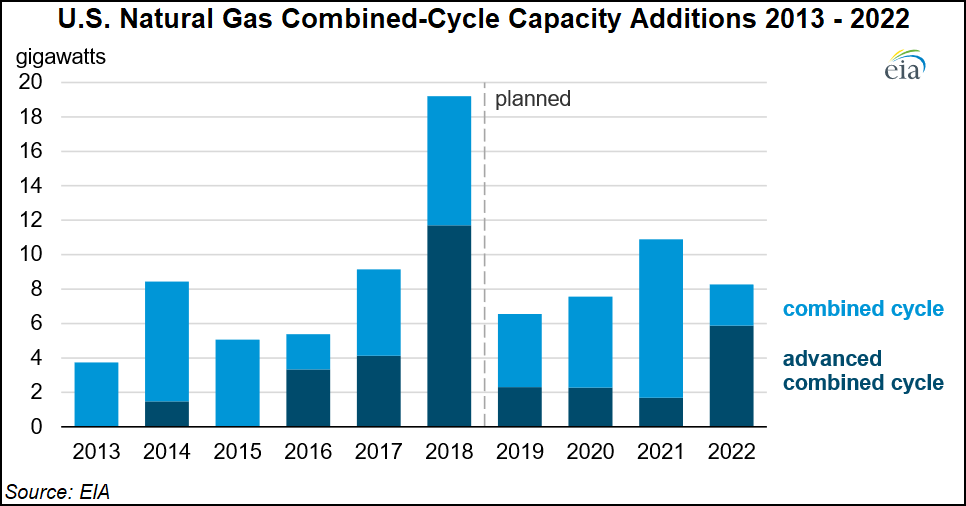NGI The Weekly Gas Market Report | Infrastructure | NGI All News Access
Advanced Combined-Cycle Tech Boosting Efficiency, Lowering NatGas Generator Costs, Says EIA
Among the wave of new natural gas-fired power plants built in recent years, a sizeable percentage of these facilities have made use of advanced combined cycle technology that is increasing efficiencies and driving down costs, according to the Energy Information Administration (EIA).

Of the generating capacity added in the United States since 2016 to take advantage of abundant and affordable domestic natural gas, 31% comes from advanced natural gas-fired combined-cycle (ANGCC) units, the agency said in a research note Wednesday.
“Greater use of the new, larger ANGCC designs has led to efficiency gains and economies of scale, which have resulted in reduced capital construction costs,” EIA said. “These lower costs are likely to substantially increase ANGCC’s share of new U.S. natural gas capacity additions in future years.”
Gas-fired generating units have evolved over the past few decades, going from the 20 MW gas-fired turbines that first became available in the early 1960s to turbines rated at 200 MW by the late 1990s.
“With firing temperatures that are more efficient, today’s ANGCC units are rated at 320 MW,” EIA said, and this higher output has led to greater economies of scale. “…The latest generation of larger Frame H natural gas-fired turbines was first installed in 2015 and was incorporated into the design for 45% of the combined-cycle units installed in 2017.
“Based on EIA’s survey of announced capacity additions, Frame H turbines are expected to be incorporated in 33% of future natural gas combined-cycle power plants through 2020 and in close to 40% of those installed in 2021 and 2022.”
Citing data from grid operator PJM Interconnection, EIA noted that the cost per unit of ANGCC installed capacity at PJM’s next capacity auction is expected to be 25-30% lower than older, conventional natural gas-fired combined-cycle (NGCC) units. Such a decline would put ANGCC costs slightly ahead of combustion turbines.
The additional capacity associated with ANGCC also equates to a lower cost per kw for new ANGCC units versus NGCC.
“From 2013 through 2016, average reported construction expenditures for new ANGCC units were $936/kw, which was 26% lower than the $1,270/kw average cost of NGCC units and 20% higher than the $770/kw average costs reported for a simple-cycle combustion turbine,” EIA said.
EIA’s reference case projection through 2050 shows the attractive economics of ANGCC units could potentially lead to the installation of 235 GW of the technology, assuming no changes in current laws or policy.
© 2024 Natural Gas Intelligence. All rights reserved.
ISSN © 1532-1231 | ISSN © 2577-9877 | ISSN © 1532-1266 |
